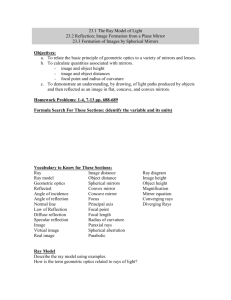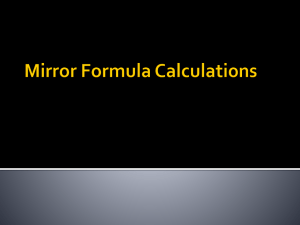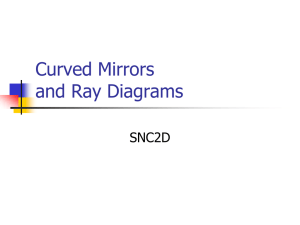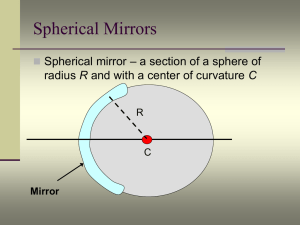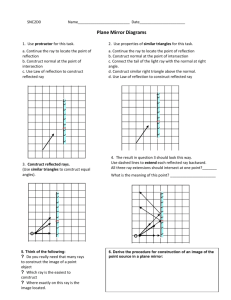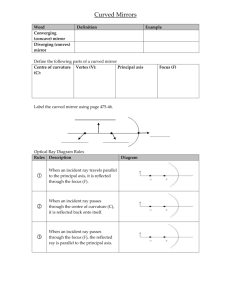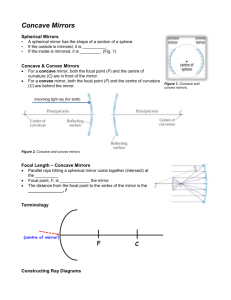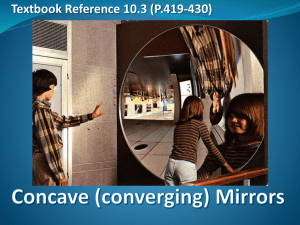Concave Mirrors
advertisement
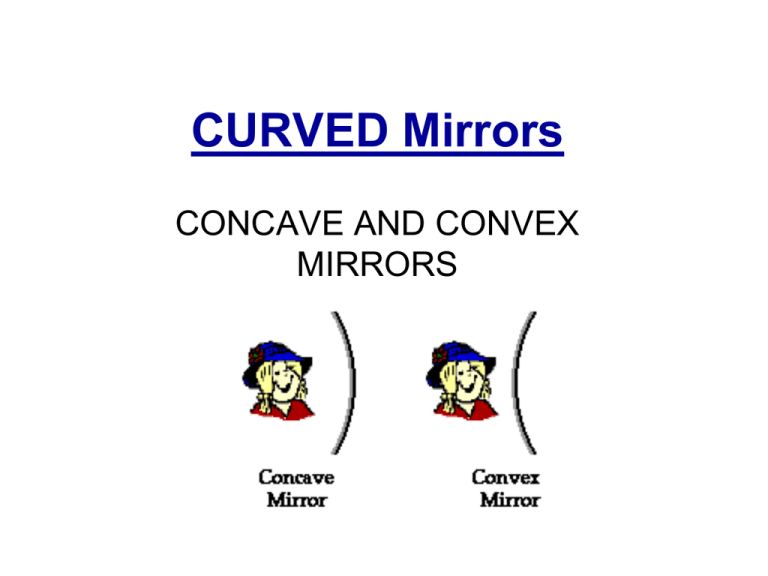
CURVED Mirrors CONCAVE AND CONVEX MIRRORS USES • FLASHLIGHT • HEADLIGHT OF CAR • SEARCH LIGHT • MAKE UP MIRROR • SATELLITE DISH The Anatomy of a Curved Mirror Curved mirrors are created when you make part of the surface of a sphere reflective. • CONCAVE • REFLECTION ON INNER SURFACE OF SPHERE • aka Converging mirror CONVEX • REFLECTION ON OUTERSURFACE OF SPHERE • aka Diverging Mirror TERMINOLOGY OF CONCAVE MIRRORS PRINCIPAL AXIS Line passing through the center of the sphere and attaching to the mirror in the exact center of the mirror; CENTRE OF CURVATURE The point in the center of sphere from which the mirror was sliced; VERTEX (A) Point on the mirror’s surface where the principal axis intersects the mirror; RADIUS OF CURVATURE (R) The distance from the vertex to the center of curvature FOCAL LENGTH (f) The distance from the mirror to the focal point The focal length is one-half the radius of curvature. FOCAL POINT FOCAL POINT (F) • Midway between the vertex and the center of curvature; • Point in space at which light incident towards the mirror and travelling parallel to the principle axis will meet after reflection; RULES OF REFLECTION FOR CONCAVE MIRRORS • • • • A light ray parallel to the principal axis is reflected through the focus. A light ray through the Centre of Curvature is reflected back onto itself. A ray through the Focus will reflect parallel to the principal axis. A ray aimed at the Vertex will follow the law of reflection. Ray Diagrams - Concave Mirrors An object is located beyond the center of curvature (C) of a concave mirror: 1. Pick a point on the top of the object and draw two incident rays (1parallel to the principal axis and the other through the focal point) traveling towards the mirror. 2. Reflect those rays according to the Rules of Reflection for concave mirrors: 3. Mark the image of the top of the object: 4. Repeat the process for the bottom of the object: Ray Diagram for Object located at C Ray Diagram for Object located between C and F IMAGE (REAL OR VIRTUAL) In the case of the object being located beyond C, the case of the object being located at C, and the case of the object being located between C and F a REAL IMAGE is formed. Ray Diagram for Object located in front of F Ray Diagram for Object located at F Two Rules of Reflection for Concave Mirrors 1. Any incident ray traveling parallel to the principal axis on the way to the mirror will pass through the focal point upon reflection. 2. Any incident ray passing through the focal point on the way to the mirror will travel parallel to the principal axis upon reflection.
